Food pairing is an essential technique used by professional chefs to create harmonious and complementary flavors in their dishes. By understanding the science behind food pairing, you can elevate the flavor profiles of your meals and discover new and exciting combinations. Let’s explore the art and science of fruit and spice pairings and how they can take your cooking to the next level.
Key Takeaways:
- Food pairing is a technique used by professional chefs to create complementary flavors in dishes.
- Understanding the science behind flavor pairing can enhance the flavor profiles of your meals.
- Fruit and spice pairings offer a world of exciting combinations for your cooking.
- Exploring regional cuisines can inspire new and unique flavor combinations.
- Experimenting with different fruit and spice pairings can unlock culinary creativity.
The Science Behind Food Pairing
Food pairing is more than just a culinary technique – it’s a science that unlocks the potential for exciting and harmonious flavor combinations. By understanding the principles behind food pairing, chefs can create dishes that go beyond simply tasting good. The art of pairing ingredients based on their complementary flavors and flavor profiles leads to truly exceptional culinary experiences.
When it comes to food pairing, it’s all about finding ingredients that enhance and balance each other’s flavors. By combining complementary flavors, chefs can create a harmonious symphony of taste sensations. For example, pairing a sweet ingredient with a tangy or savory one can create a beautiful contrast that excites the taste buds.
Flavor profiles play a crucial role in food pairing. Every ingredient has its own unique flavor profile, which encompasses characteristics like sweetness, acidity, bitterness, saltiness, and umami. By understanding these profiles, chefs can create recipes that bring out the best in each ingredient and elevate the overall taste experience.
But food pairing goes beyond just flavors. Texture and aroma also play important roles in creating a well-balanced dish. Combining ingredients with different textures can create an interesting mouthfeel, while incorporating contrasting aromas can add depth and complexity to the overall experience.
Chemical reactions also come into play when it comes to food pairing. Certain ingredients react with each other at a molecular level, enhancing or changing their flavors. This is why certain combinations, like chocolate and chili or apple and cinnamon, work so well together. Understanding these reactions allows chefs to create unique and captivating flavor combinations.
Overall, food pairing is a fascinating blend of art and science. It requires an understanding of complementary flavors, flavor profiles, textures, aromas, and even chemical reactions. By mastering the science behind food pairing, chefs can create dishes that not only taste incredible but also push the boundaries of culinary creativity.
“Food pairing is more than just a culinary technique – it’s a science that unlocks the potential for exciting and harmonious flavor combinations.”
Using Taste Profiles to Create Flavor Combinations
Creating delicious dishes involves understanding taste profiles and pairing food items together. By combining sweet, sour, salty, bitter, and umami flavors, you can elevate any dish to new heights. For example, pairing a rich and savory dish with something sweet or acidic can create a balance of flavors that makes the dish more complex and enjoyable. Experimenting with bold and contrasting tastes can also create exciting flavor combinations.
When it comes to taste profiles, let’s take a closer look at the key flavor components:
| Taste Profile | Description |
|---|---|
| Sweet | Provides a pleasant, sugary taste. Commonly found in fruits, honey, and desserts. |
| Sour | Offers a tangy and acidic flavor. Found in citrus fruits, vinegar, and fermented foods. |
| Salty | Enhances savory flavors with a salty taste. Examples include salt, soy sauce, and cured meats. |
| Bitter | Provides a sharp, sometimes intense flavor. Present in coffee, dark chocolate, and certain vegetables. |
| Umami | Known as the savory taste, it adds depth and richness to dishes. Found in ingredients like mushrooms, soy sauce, and aged cheeses. |
To create flavor combinations, consider balancing and contrasting these taste profiles. Here are a few examples:
- Pairing a sweet and tangy barbecue sauce with grilled meats for a perfect balance of flavors.
- Adding a pinch of salt to a rich chocolate dessert to enhance the sweetness and create a more rounded flavor.
- Combining bitter greens with a creamy dressing to balance the bitterness and add depth to the dish.
- Utilizing umami-rich ingredients like soy sauce and mushrooms in a savory stir-fry to enhance the overall umami flavor.
Remember, taste is subjective, and experimenting with different flavor combinations is key to discovering your personal preferences. Don’t be afraid to think outside the box and try new combinations that excite your taste buds!
Now that we’ve explored taste profiles and flavor combinations, let’s dive into the world of regional cuisines in the next section.
Exploring Regional Cuisine for New Flavors
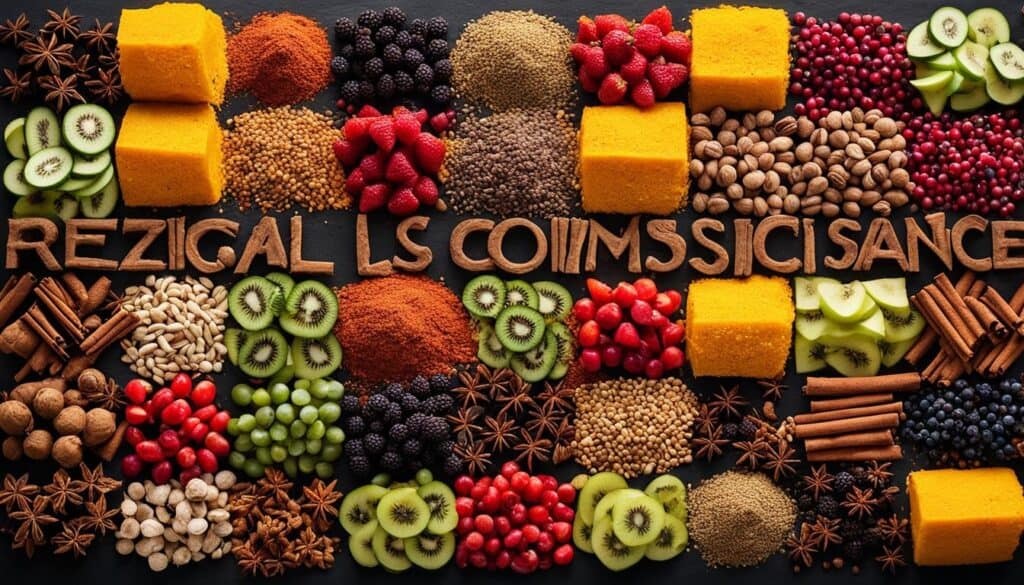
When it comes to culinary adventures, exploring regional cuisine is a gateway to discovering new and unique flavor combinations. Each culture has its own tantalizing dishes that offer a world of possibilities for your taste buds. By mixing and matching flavors from different regions, you can embark on a culinary journey like no other, creating your own custom flavor profile along the way. It’s time to ignite your taste buds and embrace the thrill of exploring regional cuisine for a one-of-a-kind gastronomic experience.
Let me take you on a virtual trip around the world, where we’ll encounter flavor combos that will ignite your culinary curiosity and spark your imagination.
Mexico: A Fusion of Spices and Bold Flavors
If you’re a fan of spicy dishes and vibrant flavors, Mexican cuisine is a treasure trove of inspiration. The combination of smoky chipotle peppers, earthy cumin, tangy lime, and aromatic cilantro creates a harmonious blend that explodes with taste. From classic dishes like tacos al pastor to mole poblano, the regional flavors of Mexico will transport you to the bustling streets of Oaxaca or the vibrant markets of Mexico City.
One flavor combo that perfectly captures the essence of Mexican cuisine is the pairing of sweet and spicy. Take the beloved Mexican hot chocolate, for example – the combination of rich cocoa and a hint of cinnamon creates a luxurious and comforting drink that dances on your palate. The contrast of sweetness with a touch of heat is a hallmark of Mexican cuisine, providing an exhilarating experience for your taste buds.
Italy: The Symphony of Flavors
When it comes to flavor combos, Italian cuisine is a maestro. From the simplicity of a classic margherita pizza to the complex layers of a hearty lasagna, Italian dishes are a symphony of flavors that celebrate the natural essence of each ingredient. The combination of ripe tomatoes, fragrant basil, fruity olive oil, and savory Parmesan cheese creates a flavor harmony that instantly transports you to the sun-kissed hills of Tuscany.
One flavor combo that Italians have mastered is the pairing of sweet and salty. Imagine biting into a slice of ripe watermelon topped with a thin slice of salty prosciutto – the contrast of juicy sweetness with the savory, cured meat creates a flavor explosion that is both unexpected and delightful. It’s this kind of culinary creativity that sets Italian cuisine apart and keeps food lovers coming back for more.
Japan: A Celebration of Delicate Flavors
Japanese cuisine is known for its delicate flavors, meticulous presentation, and attention to detail. From the simplicity of sushi to the complex flavors of miso soup, Japanese dishes offer a culinary adventure like no other. The combination of umami-rich ingredients like soy sauce, bonito flakes, and seaweed creates a depth of flavor that is both complex and satisfying.
One flavor combo that exemplifies the elegance of Japanese cuisine is the pairing of sweet and savory. Take teriyaki chicken, for example – the marriage of sweet mirin, salty soy sauce, and tangy ginger creates a glaze that perfectly balances sweet and savory notes. The contrast of flavors is a hallmark of Japanese cooking, creating a sensory experience that is both nuanced and harmonious.
| Region | Flavor Combos |
|---|---|
| Mexico | Sweet and spicy |
| Italy | Sweet and salty |
| Japan | Sweet and savory |
Exploring regional cuisine opens up a world of flavor possibilities, allowing you to create unforgettable dishes that reflect the diversity and richness of cultures around the globe. Don’t be afraid to step out of your culinary comfort zone and try flavor combos that may seem unconventional – it’s in these moments of culinary exploration that you’ll discover the true magic of regional cuisine. So, pack your bags and embark on a culinary adventure that will captivate your taste buds and leave you craving for more!
Creating Balanced Dishes with Contrasting Elements
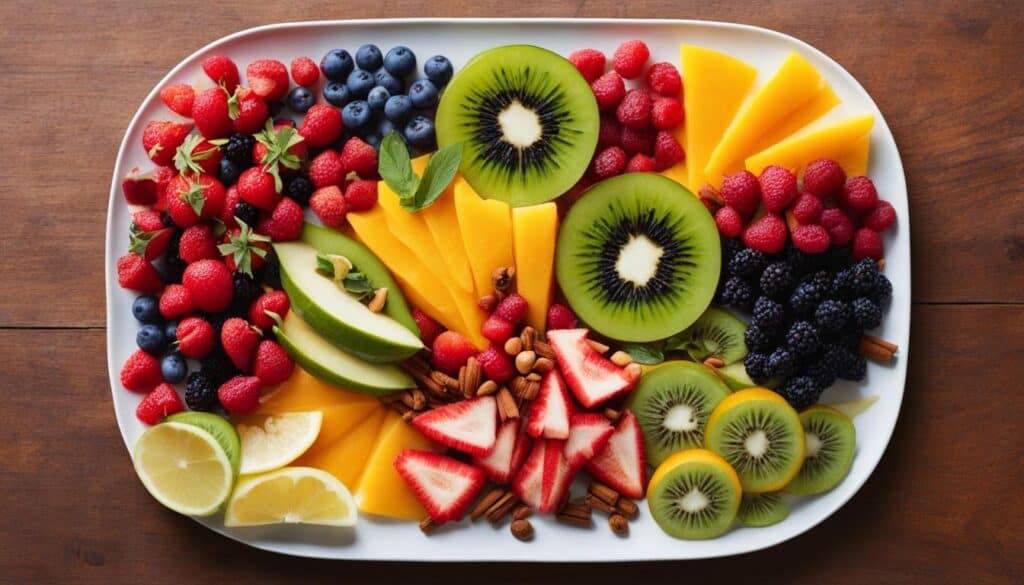
When it comes to creating dishes that are truly sensational, finding the perfect balance of flavors is key. By incorporating contrasting elements into your recipes, you can create dishes that are not only delicious but also visually stunning. A harmonious combination of contrasting flavors, textures, and colors will take your cooking to the next level.
Contrasting flavors add excitement and complexity to your dishes. Think of the sweet and tangy combination of ripe strawberries with balsamic vinegar, or the rich and creamy pairing of a velvety butternut squash soup with a drizzle of tangy lime crema. These contrasting flavor profiles create a dance of tastes on your palate, making each bite an adventure.
Textures also play a vital role in creating balanced dishes. Combining crisp vegetables with tender protein, or crunchy nuts with smooth chocolate, adds a delightful contrast that keeps your taste buds engaged. The interplay of textures adds depth and interest to your dish, making it more satisfying.
Colors shouldn’t be overlooked either. A visually appealing dish is more enticing and appetizing. Pairing vibrant red tomatoes with the deep green of fresh basil, or golden roasted vegetables with a sprinkle of bright green herbs, creates a feast for the eyes. This visual contrast makes your dish more inviting and memorable.
Experimenting with different flavor profiles, textures, and colors helps you create dishes that are not only balanced but also visually stunning. Dare to combine sweet and tangy flavors, play with textures, and embrace a vibrant palette of colors to elevate your cooking to new heights.
In the next section, we’ll delve into the power of herbs and spices, uncovering the incredible flavors they can bring to your dishes.
| Flavor | Texture | Color | Example Dish |
|---|---|---|---|
| Sweet and tangy | Crunchy and creamy | Red and green | Strawberry Spinach Salad |
| Spicy and cooling | Soft and crunchy | Orange and white | Spicy Mango Salsa with Crispy Tortilla Chips |
| Savory and citrusy | Smooth and crispy | Yellow and brown | Roasted Lemon Chicken with Crispy Potatoes |
Harnessing the Power of Herbs and Spices
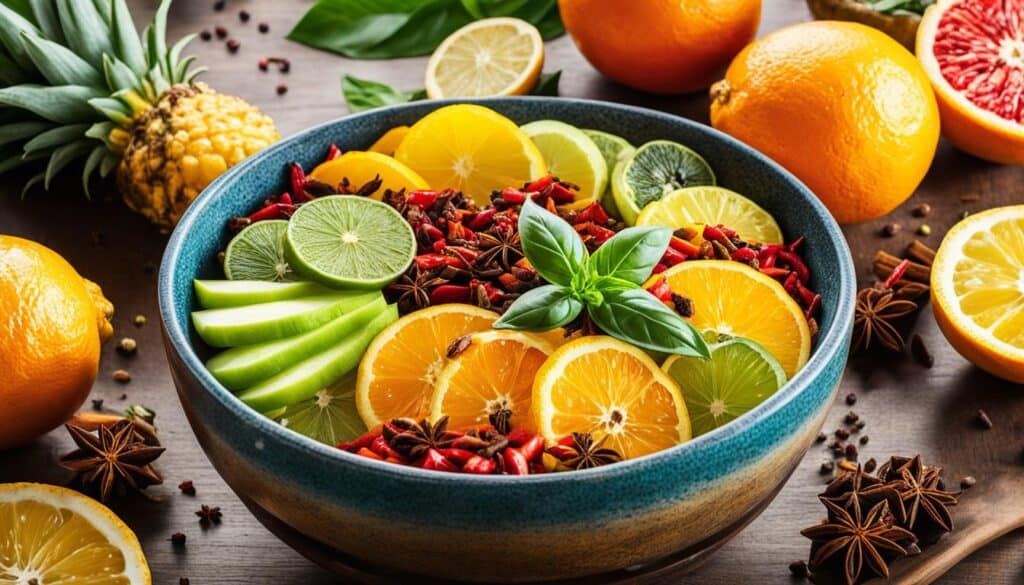
Herbs and spices are the key to unlocking unique and tantalizing flavors in your dishes. By understanding the distinct flavor profiles of different herbs and spices, you can create well-balanced and flavorful meals that will impress your taste buds and your guests.
When it comes to herbs and spices, it’s all about culinary creativity. Some spices, like cayenne pepper or cumin, are bold and assertive, adding a kick of heat or a deep smoky flavor to your dishes. On the other hand, herbs like basil or thyme are more subtle and aromatic, offering a delicate and fresh touch.
But the real magic happens when you combine various herbs and spices in small amounts. Like a symphony of flavors, these combinations can transform a simple dish into a culinary masterpiece. Whether it’s a pinch of cinnamon in your apple pie or a sprinkle of oregano on your pizza, the possibilities are endless.
So don’t be afraid to get creative and experiment with different herb and spice combinations. Mix and match flavors to create unique and exciting flavor compositions that will keep your taste buds guessing. Whether you’re trying a traditional recipe or inventing your own, the right herbs and spices can take your dish from ordinary to extraordinary.
The Magic of Herb and Spice Combinations
Combining herbs and spices is like creating a symphony of flavors in your mouth. Here are some popular herb and spice combinations that are sure to elevate your dishes:
- Rosemary and garlic: A classic combination that pairs well with roasted meats and vegetables.
- Cumin and coriander: This dynamic duo is commonly used in Indian and Mexican cuisine to add depth and warmth to dishes.
- Basil and tomato: These two ingredients are a match made in culinary heaven, commonly found in Italian dishes like Caprese salad or Margherita pizza.
- Ginger and turmeric: Known for their warm and earthy flavors, these spices are often used together in Asian dishes like curries and stir-fries.
Experimenting with different herb and spice combinations is the key to unlocking culinary creativity. Don’t be afraid to step out of your comfort zone and try something new. You never know, you might stumble upon a flavor combination that becomes your signature dish.
Remember, culinary creativity is all about exploring and pushing the boundaries. Use herbs and spices to elevate your dishes, experiment with different flavor combinations, and create meals that are bursting with flavor and excitement.
Unlocking Flavor Pairings with a Chart
Flavor pairing charts are a fantastic resource for uncovering delightful and unexpected combinations of flavors. These charts provide a visual representation of ingredients that complement one another, making it easier to explore a wide range of pairings. By referencing a flavor pairing chart, you can unlock a world of delicious combinations that will undoubtedly elevate your culinary creations.
Using a flavor pairing chart allows you to experiment with new taste profiles and discover unique flavor combinations. Whether you are a seasoned chef or a passionate home cook, this valuable tool will open up endless opportunities for culinary creativity.
By leveraging the insights from a flavor pairing chart, you can confidently combine ingredients that harmonize effortlessly, resulting in delectable and memorable dishes. Whether you’re looking to create a savory masterpiece or a sweet delight, the possibilities are endless.
Let’s say you have fresh strawberries and want to take them to the next level. Consulting a flavor pairing chart might suggest pairing them with balsamic vinegar, which enhances their natural sweetness and adds a tangy complexity. This unexpected combination can elevate a simple fruit dish to a gourmet-level indulgence.
Flavor pairing charts inspire me to step out of my culinary comfort zone and embrace new and exciting combinations. They are an invaluable resource for unlocking the potential of ingredients and creating unforgettable flavor experiences.
The valuable insights provided by a flavor pairing chart empower you to push the boundaries of your culinary creations. Whether you are a beginner or an experienced chef, this tool will guide you in creating unique and tantalizing dishes that will leave your taste buds dancing with delight.
Tips for Pairing and Layering Ingredients

Pairing and layering ingredients is a skill that can take your cooking to the next level. Just like curating an outfit or styling a room, combining ingredients for maximum effect requires intention and skill. With a deep understanding of flavor profiles, textures, ingredient quality, and proper techniques, you can create dishes that are not only perfectly balanced but also bursting with flavor. Whether you’re a seasoned chef or a home cook, these tips will help you master the art of pairing and layering ingredients for flavor-focused cooking and balanced dishes.
1. Complementing Flavors
When pairing ingredients, look for flavors that complement each other. Consider the natural affinities between certain ingredients, such as pairing tart citrus with sweet berries or pairing rich, fatty meats with acidic fruits like pineapple or mango. The goal is to create a harmonious combination where the flavors enhance and balance each other.
2. Contrasting Flavors and Textures
Don’t be afraid to experiment with contrasting flavors and textures. Incorporate elements that provide a contrast to the main flavors and textures of a dish. For example, add a crispy element to a creamy recipe or a tangy component to a rich and savory dish. These contrasts can add excitement and complexity to your dishes, making each bite a delightful experience.
3. Completing Flavors
Consider ingredients that can complete or round out the flavors of a dish. For example, a dash of acid from lemon juice or vinegar can brighten up a dish, while a touch of sweetness can balance out the heat of spices. Experiment with different complementary ingredients to complete the overall flavor profile, adding depth and complexity to your dishes.
4. Cutting Flavors
Sometimes, it’s necessary to cut through rich or heavy flavors to prevent them from overwhelming the palate. Ingredients like herbs, citrus zest, or pickled vegetables can provide a necessary contrast that cuts through the richness, creating a more balanced and enjoyable dish. Use these ingredients strategically to ensure that your flavors remain well-rounded and not overly heavy.
5. Quality Ingredients and Proper Technique
Using high-quality ingredients is essential for creating flavorful dishes. Fresh produce, spices, and herbs will provide superior taste and aroma. Additionally, it’s important to use proper cooking techniques to extract the maximum flavor from your ingredients. Techniques like roasting, caramelizing, and braising can bring out the natural sweetness and complexity of your ingredients, enhancing the overall flavor of your dishes.
“By understanding flavor profiles, textures, ingredient quality, and proper technique, you can create dishes that are perfectly balanced and full of flavor.”
Pairing and layering ingredients is a creative process that requires practice and experimentation. Don’t be afraid to think outside the box and try unexpected combinations. As you gain more experience, you’ll develop an instinct for which flavors work well together and how to achieve balance in your dishes. With these tips in mind, you’ll be well on your way to creating flavorful, balanced, and visually appealing dishes that will impress your guests and leave them wanting more.
Exploring Fruit and Spice Pairings
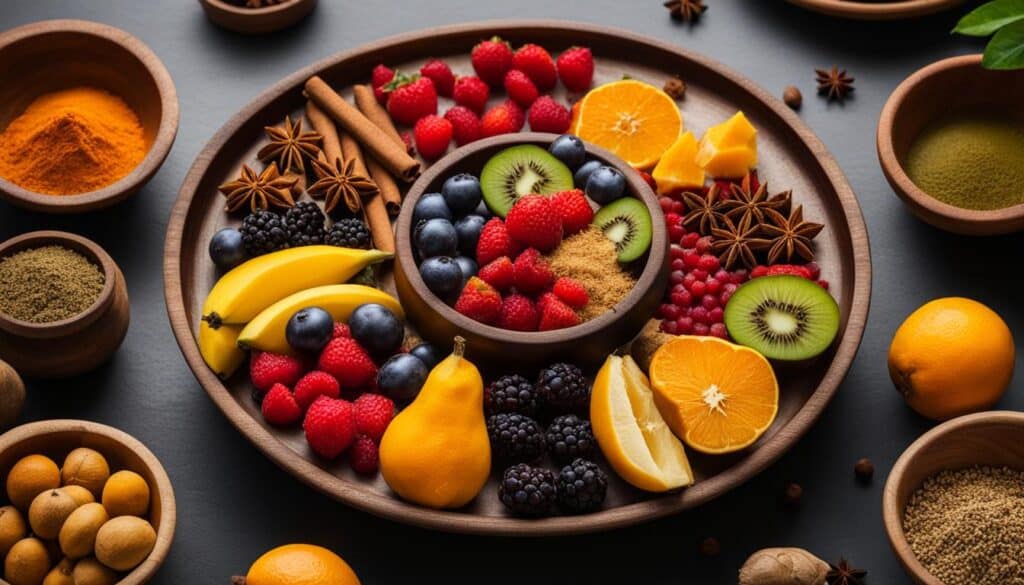
Fruit and spice pairings are a delightful way to introduce new and exciting flavors into your desserts. By combining the natural sweetness of fruit with the warmth and complexity of spices, you can create unique and unforgettable taste experiences. From classic combinations like apple and cinnamon to more adventurous pairings like mango and chili, the possibilities are endless.
When it comes to fruit and spice pairings, don’t be afraid to get creative and experiment. Let your taste buds guide you as you explore the vast array of flavor combinations. The sweetness of the fruit can balance the heat or bitterness of the spices, resulting in a harmonious blend of flavors that will truly tantalize your palate.
Here are a few fruit and spice pairings to ignite your culinary imagination:
- Strawberries and black pepper: The subtle spiciness of black pepper adds depth and complexity to the sweetness of ripe strawberries.
- Pineapple and ginger: The zingy heat of ginger complements the tropical sweetness of pineapple, creating a refreshing and vibrant combination.
- Blueberries and cardamom: The warm, aromatic notes of cardamom enhance the natural sweetness of blueberries, resulting in a flavor pairing that is both comforting and indulgent.
Remember, the key to creating unique desserts with fruit and spice pairings is to embrace your creativity and experiment with different combinations. Don’t be afraid to think outside the box and try something new. Whether you’re baking pies, cakes, or pastries, these flavor combinations will add a touch of magic to your culinary creations.
“Combining the natural sweetness of fruit with the warmth and complexity of spices can create desserts that are truly unforgettable.”
So, the next time you’re in the kitchen, why not embark on a flavorful journey by exploring fruit and spice pairings? Let your taste buds dance with delight as you discover new and exciting flavors that will make your desserts stand out from the crowd.
Delight your senses and elevate your dessert game with these unique flavor combinations. There’s no limit to what you can create when you combine the sweetness of fruit with the boldness of spices. So go ahead, let your imagination run wild, and create desserts that are sure to leave a lasting impression.
The Ultimate Fruit Flavor Pairing Chart
To help you navigate the world of fruit flavor pairings, I’ve created the ultimate fruit flavor pairing chart. This chart provides a comprehensive list of fruits and their compatible flavor pairings, making it easier to create delicious desserts. Whether you’re a seasoned baker or just starting out, this chart can serve as a valuable tool for exploring new and interesting flavor combinations in your sweet creations.
| Fruit | Compatible Flavor Pairings |
|---|---|
| Apple | Cinnamon, caramel, nutmeg |
| Strawberry | Chocolate, basil, balsamic vinegar |
| Banana | Peanut butter, coconut, caramel |
| Mango | Lime, chili, coconut |
| Blueberry | Lemon, lavender, almond |
As you can see from the chart, each fruit has its own unique flavor profile, and by pairing it with compatible flavors, you can create desserts that are bursting with deliciousness. For example, combining the sweetness of apples with the warmth of cinnamon and the richness of caramel can result in a mouthwatering apple pie. And if you’re feeling adventurous, why not try pairing the tanginess of strawberries with the earthiness of basil or the complexity of balsamic vinegar for a truly unique flavor experience?
When using the fruit flavor pairing chart, remember to trust your taste buds and get creative. Don’t be afraid to experiment with different combinations and discover your own favorite flavor pairings. And if you’re looking for some baking tips, here are a few to get you started:
- Use fresh, ripe fruit for the best flavor.
- Balance sweetness with acidity for a well-rounded dessert.
- Experiment with different textures by incorporating crunchy elements like nuts or crispy toppings.
- Don’t be afraid to mix and match flavors from different categories (fruity, spicy, herbal) for a more complex taste.
So grab your mixing bowls and let the ultimate fruit flavor pairing chart inspire your next delicious dessert creation! Happy baking!
Experimenting with Fruit and Spice Pairings
Now that you have a solid understanding of flavor pairings, it’s time to unleash your inner culinary creativity and start experimenting with fruit and spice combinations. This is where the real magic happens! Don’t be afraid to push the boundaries and explore new flavor territories. Remember, the key to unlocking unique and delicious combinations is through trial and error.
So, how do you start experimenting with flavor combinations? Here are a few tips to get you started:
- Start with familiar flavors: Begin by pairing fruits and spices that you know work well together. This will give you a solid foundation to build upon.
- Think outside the box: Don’t be afraid to think beyond traditional pairings. Explore unexpected combinations and let your taste buds guide you.
- Balance is key: Aim for a balance of flavors in your combinations. Consider the sweetness, acidity, and heat of the ingredients to create a well-rounded dish.
- Start small: Begin by incorporating a small amount of spice into your fruit dishes and gradually increase the intensity to find the perfect balance of flavors.
Don’t forget to document your experiments along the way. Keep a record of the flavor combinations you try, noting which ones work well and which ones need adjustment. This will serve as a valuable reference for future culinary creations.
To give you a little inspiration, here’s a table showcasing some popular fruit and spice pairings:
| Fruit | Spice |
|---|---|
| Apple | Cinnamon |
| Mango | Chili |
| Peach | Ginger |
| Watermelon | Mint |
| Orange | Cardamom |
Remember, this is just a starting point. Feel free to combine different fruits and spices based on your personal preferences and the flavor profiles you want to create. The possibilities are endless!
So gather your ingredients, unleash your culinary creativity, and embark on a journey of flavor exploration with fruit and spice pairings. Your taste buds will thank you!
Conclusion
Food pairing is a fascinating blend of science and art that can transform your cooking into a culinary masterpiece. By understanding the principles of flavor pairing and exploring the world of regional cuisines, you can unlock a whole new realm of flavors in your dishes. Fruit and spice pairings offer a delightful array of possibilities, inviting you to create unique and unforgettable culinary experiences.
Whether you’re experimenting with traditional combinations like apple and cinnamon or exploring more adventurous ones like mango and chili, the fusion of fruit and spice brings a harmonious balance of sweetness and warmth to your recipes. These pairings not only tantalize the taste buds but also enhance the visual appeal of your creations.
So, let your imagination run wild, embrace your culinary creativity, and embark on a flavorful journey with fruit and spice pairings. From luscious desserts to savory dishes, the combinations are endless. Trust your taste buds to guide you and savor every moment in the kitchen. Happy cooking!
FAQ
What is food pairing?
Food pairing is the deliberate combining of ingredients based on their flavor and aroma to create harmonious and complementary flavors in dishes.
How can understanding food pairing elevate the flavor profiles of meals?
By understanding the science behind food pairing, chefs can unlock endless possibilities for culinary creativity and create dishes that not only taste good but also complement each other perfectly.
How can taste profiles be used to create flavor combinations?
By combining sweet, sour, salty, bitter, and umami flavors, chefs can elevate dishes to new heights and create complex and enjoyable tastes.
How can exploring regional cuisines help in discovering new flavors?
Each culture has its own tantalizing dishes that offer a world of culinary possibilities. By mixing and matching flavors from different cultures, you can create your own custom flavor profile and discover delicious surprises.
How can contrasting elements create balanced dishes?
By combining sweet and tangy, sharp and creamy, or earthy and sharp flavors, dishes can be visually appealing and keep taste buds engaged with every bite.
How can herbs and spices unlock unique flavors in dishes?
Understanding the flavor profiles of different herbs and spices is key to creating well-balanced dishes. Using a variety of herbs and spices in small amounts can create a symphony of flavors in meals.
How can a flavor pairing chart assist in discovering new combinations?
Flavor pairing charts provide a visual representation of ingredients that complement each other, making it easier to experiment with different pairings and discover delicious combinations.
What are the principles to keep in mind when pairing and layering ingredients?
Complementing, contrasting, completing, and cutting flavors are key principles when pairing and layering ingredients to create balanced and flavorful dishes.
What are some examples of fruit and spice pairings?
Fruit and spice pairings can include classics like apple and cinnamon and more unique combinations like mango and chili, offering a world of exciting flavor possibilities.
How can a fruit flavor pairing chart be helpful in creating delicious desserts?
The ultimate fruit flavor pairing chart provides a comprehensive list of fruits and their compatible flavor pairings, making it easier to create delicious and unique desserts.
How can experimenting with fruit and spice pairings enhance culinary creativity?
By trying new combinations and thinking outside the box, chefs can discover unique flavor profiles and create extraordinary dishes.
How can understanding the art and science of food pairing take your cooking to the next level?
Understanding flavor pairings, exploring regional cuisines, and experimenting with different combinations can help create dishes that are not only delicious but also visually stunning, elevating your cooking to new heights.

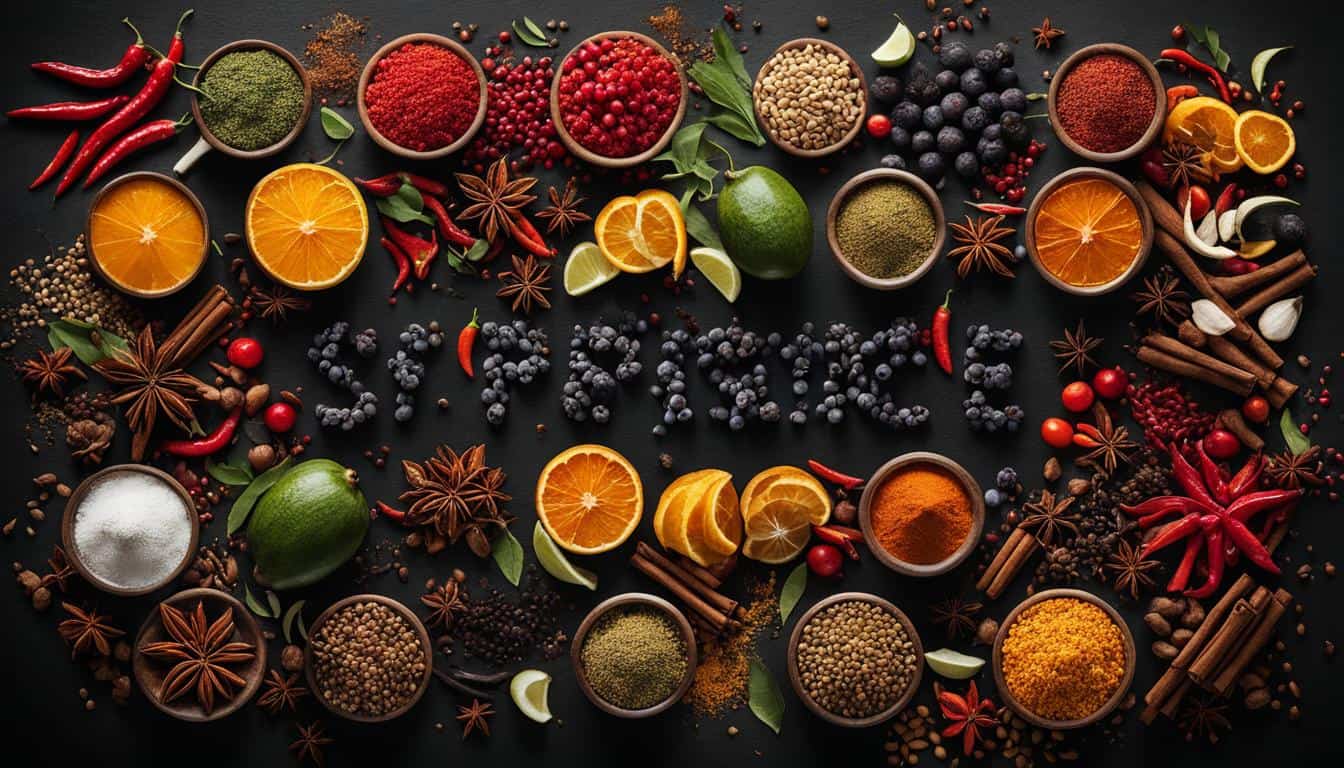



Leave a Reply